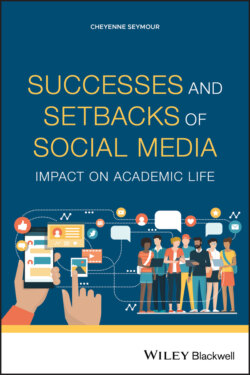Читать книгу Successes and Setbacks of Social Media - Группа авторов - Страница 14
References
Оглавление1 Al-Samarraie H. (2019). A scoping review of videoconferencing systems in higher education: Learning paradigms, opportunities, and challenges. International Review of Research in Open and Distributed Learning 20 (3): 121–140. https://doi.org/10.19173/irrodl.v20i4.4037.
2 Berk R.A. (2009). Multimedia teaching with video clips: TV, movies, YouTube, and mtvU in the college classroom. International Journal of Technology in Teaching and Learning 5 (1): 1–21.
3 Bowman N.D., and Akcaoglu M. (2014). “I see smart people!”: Using Facebook to supplement cognitive and affective learning in the university mass lecture. The Internet and Higher Education 23: 1–8. https://doi.org/10.1016/j.iheduc.2014.05.003.
4 Fleck B.K.B., Beckman L.M., Sterns J.L. et al. (2014). YouTube in the classroom: Helpful tips and student perceptions. Journal of Effective Teaching 14 (3): 21–37.
5 Grandoni D. (2013). First YouTube video, “Me At The Zoo,” was uploaded eight years ago, an April 23. HuffPost (23 April).
6 Gregory P., Gregory K., and Eddy E. (2014). The instructional network: Using Facebook to enhance undergraduate mathematics instruction. Journal of Computers in Mathematics and Science Teaching 33 (1): 5–26.
7 Hurt N.E., Moss G.S., Bradley C.L. et al. (2012). The “Facebook” effect: College students’ perceptions of online discussions in the age of social networking. International Journal for the Scholarship of Teaching and Learning 6 (2): 1–26.
8 Junco R., Elavsky C.M., and Heiberger G. (2013). Putting Twitter to the test: Assessing outcomes for student collaboration, engagement and success. British Journal of Educational Technology 44 (2): 273–287. https://doi.org/10.1111/j.1467–8535.2012.01284.x.
9 Kassens A.L. (2014). Tweeting your way to improved #writing, #reflection, and #community. The Journal of Economic Education 45 (2): 101–109. https://doi.org/10.1080/00220485.2014.889937.
10 Khan Academy. (2020). A personalized learning resource for all ages. About (9 June).
11 Lage M.J., Platt G.J., and Treglia M. (2000). Inverting the classroom: A gateway to creating an inclusive learning environment. Journal of Economic Education 31 (1): 30–43. https://doi.org/10.2307/1183338.
12 Malouff J.M., and Emmerton A.J. (2014). Students can give psychology away: Oral presentations on YouTube. Psychology Learning and Teaching 13 (1): 38–42.
13 Malouff J.M., and Shearer J.J. (2016). How to set up assignments for students to give oral presentations on video. College Teaching 64 (3): 97–100. https://doi.org/10.1080/87567555.2015.1125840.
14 Marlow S.L., Lacerenza C.N., and Salas E. (2017). Communication in virtual teams: A conceptual framework and research agenda. Human Resource Management Review 27 (4): 575–589. https://doi.org/10.1016/j.hrmr.2016.12.005.
15 Rusk M.D. (2000). Video projectors: Media services in the high technology classroom. Community and Junior College Libraries 9 (3): 55–59. https://doi.org/10.1300/J107v09n03_08.
16 Sheeran N., and Cummings D.J. (2018). An examination of the relationship between Facebook groups attached to university courses and student engagement. Higher Education 76 (6): 937–955. https://doi:10.1007/s10734%E2%80%93018%E2%80%930253%E2%80%932.
17 Vimeo. (2020). Our passionate community. About (9 June).
